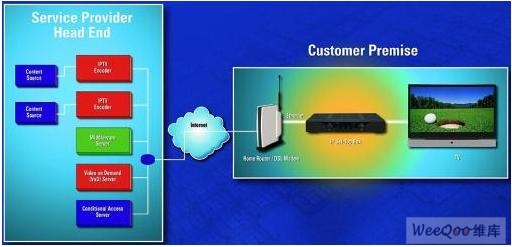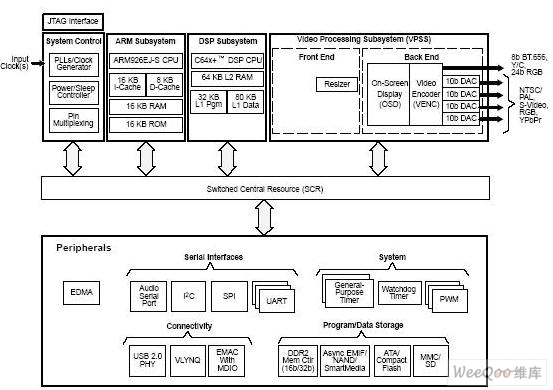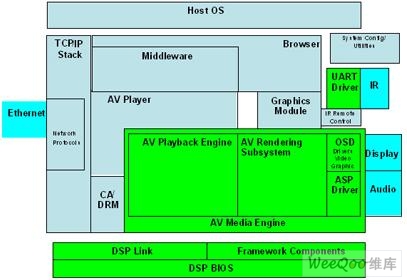As the IPTV market prepares to take off, the increase in the number of competing ecosystems means that STB developers must keep their implementation options open.
In the next few years, the IPTV market (using digital protocols to transmit digital TV) promoted by telecom service providers is expected to form a scale. However, the market is currently in competition for a variety of hardware and software solutions, and the different types of compression technologies are complex and potentially integrated with home networking applications. These factors make engineers face decision-making difficulties in designing IP set-top boxes, so original equipment manufacturers (OEMs) need to choose processing technologies to keep them open for implementation options.
As the focus of the transmission solution, the STB must be able to adapt to the requirements of the particular IPTV "ecosystem" it is deploying, so interoperability and the performance required to handle high throughput video is critical to these systems. Scalability is also important for many new applications that IPTV networks may offer; and cost is always a problem for consumer appliances. STB design engineers have seen that highly integrated digital signal processing (DSP) meets these requirements by providing affordable, high-real-time performance and reprogramming for new configurations, refreshes, upgrades, and applications.

Figure 1: IPTV ecosystem
IPTV ecosystem
The design of the STB involves all the equipment and software in the IPTV ecosystem. The main project is shown in Figure 1. At the front end, service providers transmit encoded video for IPTV from sources such as terrestrial broadcasts, pre-recorded proprietary content, satellite TV channels, etc. Content can also be provided directly by VOD service providers.
To ensure proper reception, all such content is transmitted through the Conditional Access Server (SAS), which provides security for transmission through encryption, authentication and authentication. The middleware server is responsible for coordinating these units, monitoring customer requests, communicating with other servers, and scheduling transmissions, and providing an interface for network management for service assurance, billing, maintenance, and other necessary services. This server also communicates with the customer's STB to manage these requests and provide a friendly graphical user interface (GUI).
The client in the figure shows a DSL modem and STB, which in some cases may be combined in a single box. The STB receives and decodes the IPTV signal from the broadband connection and then outputs one or more video streams for display by the television. It should be noted that most of the proposed solutions do not include broadband open access to the Internet through the STB, but this feature may be supported in the future.
STB browser and middleware
At the top of the STB is the operating system (OS) such as WinCE, Linux or VxWorks that hosts the browser. Its role is the graphics engine, through which it interacts with the middleware, allowing users to easily access interactive services. The middleware client software coordinates access to the network. Some browser and middleware clients are based on HTML with JavaScript; others are based on Java and run on the Java Virtual Machine (JVM) in the STB. In order to get more complex graphics processing capabilities, emerging options integrate middleware with Macromedia Flash or Dynamic HTML.
Each of these options is more complex and requires more processing performance, so STB processors need to be scalable to support these different combinations. If you separate graphics and video processing-intensive tasks from common operational tasks, the processing architecture can accelerate the overall performance of the system and provide overhead for scalability.
Service providers have built their own systems, and STBs must interwork with these systems to be used in different IPTV environments. Each deployment has a unique network configuration and a range of companion options, so middleware, browsers and other software continue to evolve with the addition of new features and services. OEMs must consider whether the performance of a given processor allows the system to be scalable to support these changes and perform new tasks.
Provide security
Software-based conditional access (CA) systems - very similar to digital rights management (DRM) software - employ security standards such as AES or 3DES to enable key exchange for conditional access. If the hacker attempts to open the key, the programmable processor allows the STB to make quick modifications to enhance the security level.
The traditional hardware-based CA approach uses smart cards and fixed hardware to protect the system from insecure access. Like software-based systems, these hardware-based security systems must be continuously upgraded to defeat hacker attacks; therefore, CA vendors have built different levels of security in their designs to support not only old usage, but also Meet the new receiving conditions in the future. (rewrite)
These security features require the creation of intellectual property into the processor; and because each CA vendor has its own settings, the STB manufacturer needs to ensure that all major vendors are properly supported.
Recently, watermarking systems have attracted the interest of content owners, service providers, and manufacturers who provide them with IPTV devices. In the case where the content is received without proper authorization, the watermarking technique allows the service provider to quickly locate such illegally received locations where the CA is to be upgraded.
Video coding and VOD
MPEG-2 is the old-generation video codec (encoder/decoder) currently used in the industry. It has been used in standard definition television for many years and is now often used in high definition television. The original IPTV adopted the MPEG-2 standard. However, in order to increase bandwidth utilization and increase the number of homes accommodated, many service providers are adopting more advanced multimedia digital codec standards such as H.264. /MPEG-4 part 10/AVC and WMV9/VC1. The bandwidth utilization of these newer codecs is typically two orders of magnitude higher than MPEG-2. In addition to these popular advanced codecs, China is deploying its own new standard, AVS.
Accompanied by the video codec are audio codecs that use various audio compression standards. Also consider: within each codec specification, there is some room for interpretation, allowing encoder vendors to continuously enhance their products to achieve better quality and reduce bitrate. Therefore, there are several possible combinations of audio and video codecs that are slightly different in implementation from the different encoder vendors' schemes.
The basis of video on demand communication is RTP and RTSP; RTP is the streaming protocol for downlink transmission, and RTSP is the control protocol for data, both of which allow great flexibility in implementation. In order to make interoperability more complicated, different VOD vendors use different offline encoders with full autonomous coding characteristics. To reduce the problem, VoD servers from different vendors may be installed by an IPTV service provider.
Faced with multiple codecs, different types of codec combinations and implementations, and different protocol interpretations, all of these factors require flexibility and scalability of the STB to be designed to support wide-change, continuous upgrade interoperability. Sexual requirements.
Home networking
Because STB shares most of the technology used in Digital Media Adapters (DMA), STB is also expected to connect to home networks via Ethernet, HomePlug, WLAN or Moca. The STB can then receive and play content downloaded from a personal computer, such as displaying a photo folder, playing music, or even downloading a video from the Internet. It should be considered that the STB may also be equipped with its own hard disk to record the content played by the IPTV, and then the content can be shared via the Internet.
If the STB is connected to an entertainment system such as a networked DVD player, sound system and game console, then the possibility of convergence is even more interesting. Ultimately, applications such as video telephony and online video may also be integrated with the STB, bringing their own range of interoperability issues.
In order to be able to handle these new converged applications, it is essential that the STB must support the standards used by various home appliance systems, and because of the different needs in the home network, it also provides users with a variety of services. For example, if a 4Mbps MPEG2 stream is converted and encoded into a 1.5-Mbps WMV9 stream, the bandwidth can be maintained and the content stored in a given hard disk space can be increased.
As an example, switching from CA to DRM security ensures protection of video content within the home network. Industry Alliances - Digital Living Network Alliance - is concerned with developing interoperability standards for home networks, and the most popular products on the home network today follow the DLNA standard.
STB processor requirements
While people are deploying different IPTV ecosystems, interoperability in different systems and configurations is not only important in the short term, but also important in the long run as things continue to evolve. STB will have to adapt as different service providers begin to configure possible combinations of products from many operating systems, compression technologies, middleware, browsers, CA/DRM, real-time encoder vendors and VoD server vendors. This multi-combined application requirement is also designed to meet the requirements of providers adding new services to their products. A successful STB design will rely on a processing solution that delivers high performance, programming flexibility, scalability, and high system level integration.
Audio and video codecs, graphics acceleration, communications, and many potentially converged home applications will require advanced performance, most of which are required for real-time signal processing. Performance can be enhanced by using an accelerator and software partitioning the signal processing tasks. For example, video decoding is best handled by a DSP that is engaged in control tasks, and the user interface is better handled by a RISC processor. By running the most appropriate tasks on the processor, design engineers can ensure the highest performance and highest efficiency product design.
An example of a DSP media processor
TI's TMS320DM*x digital media processor meets the requirements of the IP STB for DSP. The advanced C64x+ DSP core integrates a video coprocessor that provides the high-speed computing power required for video encoding and decoding, as well as an ARM926 RISC processor that handles the user interface, enables system control, and is easy to program. System-on-a-chip (SoC) also integrates network peripherals, audio and video interfaces, high-speed storage subsystems, external storage interfaces, and enhanced direct access interfaces (EDMA), so the hardware in the BOM is reduced by up to 50%.
Figure 2 shows the functionality of the DM*3 processor, which is designed for decoding systems like STB. Another device, code and lead-compatible DM*6 provides a convenient upgrade solution for adding decoding capabilities.

Figure 2: Block diagram of DM*3
The DM*x processor can be programmed to support any number of audio and video standards and can be easily upgraded by downloading the changes required for network configuration and service. Software partitioning of mathematically intensive signal processing on DSP and video accelerators and control operations on ARM processors can provide significant performance overhead for other applications. As a key component of TI's DaVinci technology, the DM*x processor is supported by basic software and APIs to make video system development more straightforward and to simplify interoperability between customers.
DSP-based STB software architecture
Figure 3 shows the basic software architecture diagram of a DM*x-based IP STB with application software such as the main operating system, browser, and middleware in the stack. The basic part is the DSP/BIOS real-time operating system and link and the framework for communication between RISC and DSP. At the top of the layer is the basic video presentation and playback software portion of the audio and video (AV) media engine.
The browser with its graphics engine, client middleware and conditional access are all connected to the media engine via an AV player, which is the key link between the application and the codec engine. Various application software is connected to the main operating system, among which are the drivers, TCP/IP stacks and other network protocols necessary to provide communication and external interfaces.

Figure 3: IPTV client software system
Interoperability in a changing market
As the IPTV market prepares to take off, the number of competitive ecosystems is increasing, meaning that STB developers must keep their implementation options open. Interoperability is the key to success in the current market environment. High-performance DSPs provide the programming flexibility needed to ensure interoperability and ensure the versatility of the solution in a changing IPTV ecosystem. SoC integration solutions bring these benefits at an affordable price, and software makes development faster and easier. In the evolving IPTV market, DSP-based STBs will be able to adapt quickly and productively to change.
:
Ecological Furniture Board,Poplar Plywood,Furniture Board Size
Hand Tools Co., Ltd , http://www.nshandtools.com